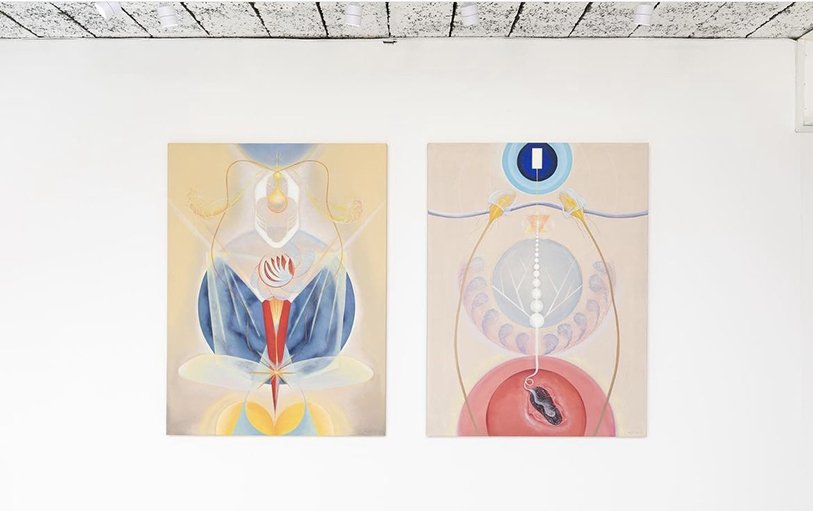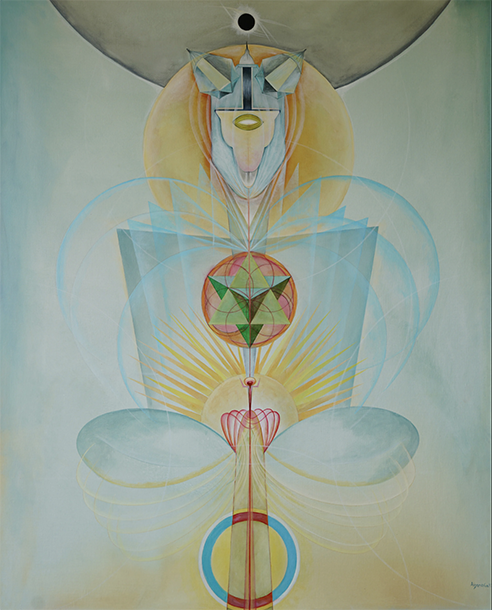Touching the Sky with Aigana Gali
Rendering biomorphic shapes and symbols with a luminous application of colour, Aigana Gali (b. 1980, Kazakhstan) fluidly reconciles the opposing properties of light and shadow on her celestial canvases. Born on the ancient crossing of the Great Silk Road in Kazakhstan, Gali spent her formative years in the endless plains of the Eurasian Steppe. Gali explores ways to communicate her cultural milieu through her work, in particular the tonal shifts and vibrational quality of light found in the vast plains where she grew up. Her practice is also a manifestation of the artist’s inner landscape. Layering geometric, mythical forms on infinite planes, the artist has developed a unique language that threads through all of her work. Gali’s practice not only embodies the mythical quality of light found in nature and the cosmos, but also unveils the artist’s enlightened state of consciousness.
Aigana Gali came to prominence with her solo exhibition Steppe at the Georgian National Museum of Art. Her work has been widely exhibited at solo and group shows around the world, including the Royal Academy of Arts, Kasteyev Museum of Arts, Kristin Hjellegjerde Gallery, Kwai Fung Hin Gallery, Hay Hill Gallery, Ark Art Gallery, and Saatchi Gallery. Gali is represented by Kristin Hjellegjerde Gallery in London, UK. Her work is currently on view at Kwai Fung Hin gallery, Hong Kong, as part of the exhibition Lightness of Being curated by Claudia Cheng.
What brought you into the art world? Do you have any memories from your childhood that drove you to become an artist?
Painting and drawing have been my natural way of conversing with the world ever since I can remember. I have never had a moment where I consciously decided who I wanted to be. It was never a choice for me. I am lucky to be born with a brush in my hand. I come from a family gifted with creative talents, and I was happy to take my turn.
I’m not saying that I had the skills from the start. Of course I had to learn the craft, but my creative process was always with me. It is where I feel most beneficial for the world around me.
Can you describe your creative process? Tell me about the mythical, symbolic forms in your work.
To me, every artist is a shaman who touches the sky and channels information for us to receive universal messages. The media and the techniques play a secondary role in this.
I don’t have a specific routine as a creative process. There is no plan for my work, I usually only see one step ahead.
I reflect on universal archetypes and try to grasp them through colour and composition. It feels like working in a dark room, developing a photographic image. It is a fascinating process of letting go of ego and giving way for the vision or the message to unravel.
Aigana Gali, KOZ, 2022. Oil and acrylic on canvas.
Where do you draw your inspiration from?
My inspiration comes from everywhere and never leaves me. I am always ready to work as long as I am in good physical and moral shape. I don't take myself too seriously personally, but I am strict and serious about being available for the process of creating. I see myself as a tool, and I ensure that the tool is sharp and clean for the picture to come out without being obstructed by my personal story. I believe in discipline and that an artist should work daily to continue developing the message.
How did growing up in the endless plains of the Eurasian Steppe influence your practice?
I can see the nature of my land in everything I do. Kazakhstan is dominated by vast barren lands of the Central Asian steppe. Just like the ocean, it is a vast horizon of "nothing" that holds infinite magic inside. My Steppe paintings describe the ever-changing theatre of light and colour found in these wide-open, empty spaces. So much negative space and nothingness, yet, it had enough of everything for me. I wanted to make paintings out of this nothingness that is paradoxically so full of life, light, and colour.
Aigana Gali, Khan Tengri, 2022. Oil and acrylic on canvas.
Aigana Gali, Mediator V, 2022. Oil and acrylic on canvas.
I’m delighted that you created new paintings for the show Lightness of Being I curated for Kwai Fung Hin. Is there a story behind this body of work?
The three paintings I created for the show are part of my Tengri series. They represent an evolution from the abstract colour fields of my Steppe paintings (nothingness) to the geometric forms of Tengri Lightworks (being).
Tengrism is an ancient Turko-Mongolic religion originating in the Eurasian steppes, generally centered around the sky God Tengri. Tengri was not considered a deity in the usual sense, but a personification of the universe.
Tengri is about what happens when I close my eyes and travel inwards to receive messages through my body. There is a figurative aspect to these paintings which is more about the body being a tool, a medium. Tengri comes out of the empty spaces, from the constant solitude experienced by people who for millennia have called the Steppe home. You cannot hide there. The meaning of life for followers of the Tengri is to be at one with nature, and in this we are sustained by both the spirits of heaven and earth: the eternal blue sky and the warm yellow mother beneath our feet.
What are you working on next?
I trust the energy that takes me through my creative process and never plan what I will do next. I observe this automatic flow while creating paintings in my studio every day.
I had an exciting development a few years ago. One day, after working in my studio, I looked at my painting and couldn't see myself in it. This made me realise that my art is not meant to be a form of self-expression. Although I had been working hard all my life–literally on my knees on the floor most of the time–bearing the uncertain social status of being an artist, in that moment I realised that my art isn’t about me. I felt liberated by the idea that art is the process of letting go of my ego.
After that day, my creative process changed. These creations are the result of artistic rituals. I have no desire to predict, judge, or own them. My only wish for the future is to be able to continue to work more and increasingly lose the imprints of my ego on what I create.




